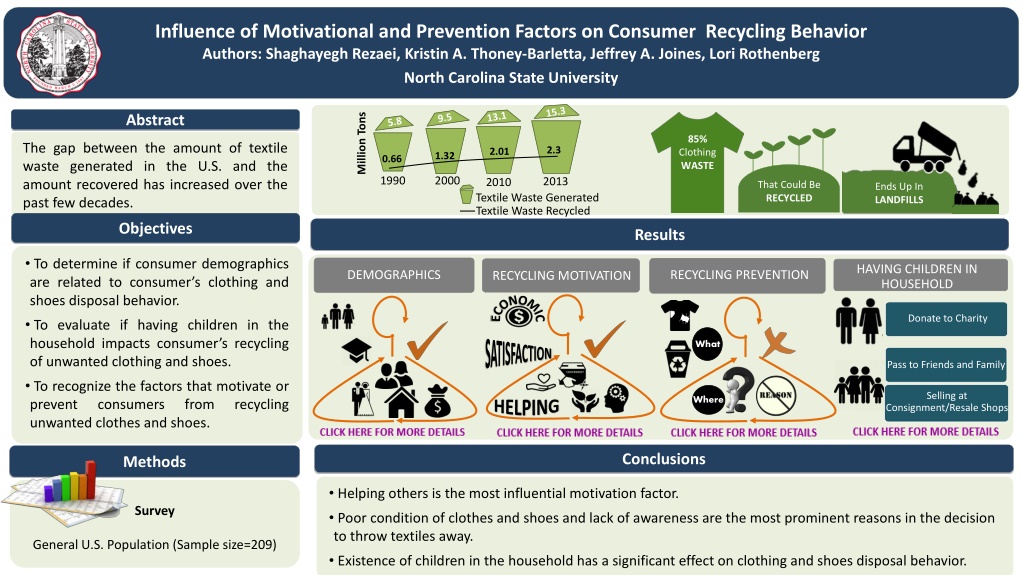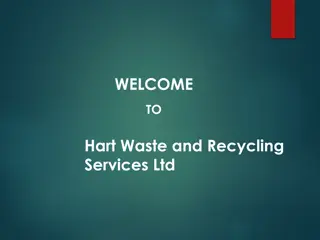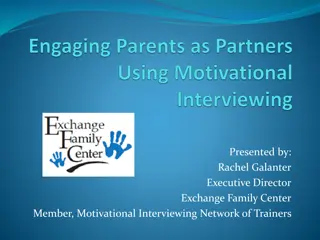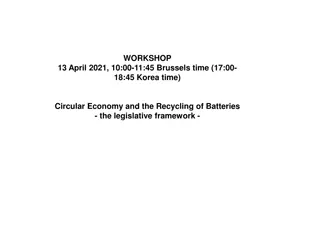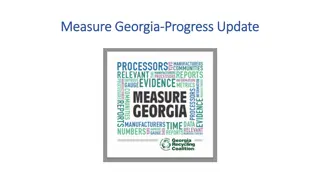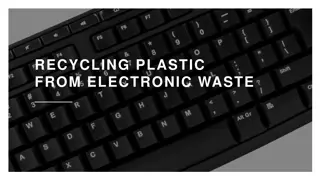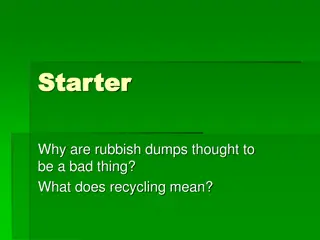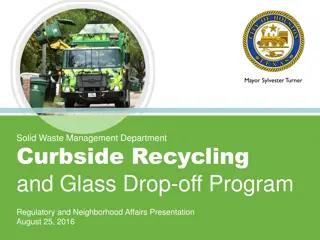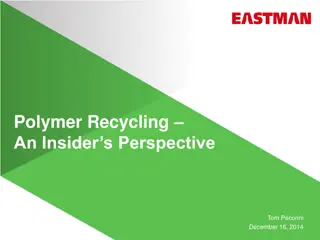Impact of Motivational and Prevention Factors on Consumer Recycling Behavior
The study explores how motivational and prevention factors influence consumer recycling behavior, particularly regarding clothing and shoes disposal. Findings suggest that helping others is a significant motivation, while poor condition of textiles and lack of awareness lead to disposal. Demographic factors like income level and presence of children in the household also affect recycling habits. Additionally, gender, income, marital status, and homeownership correlate with textile recycling behavior. Motivation factors analyzed include helping the less fortunate, economic incentives, and satisfaction from various actions like donating to charity and selling items.
Download Presentation

Please find below an Image/Link to download the presentation.
The content on the website is provided AS IS for your information and personal use only. It may not be sold, licensed, or shared on other websites without obtaining consent from the author. Download presentation by click this link. If you encounter any issues during the download, it is possible that the publisher has removed the file from their server.
E N D
Presentation Transcript
Influence of Motivational and Prevention Factors on Consumer Recycling Behavior Authors: Shaghayegh Rezaei, Kristin A. Thoney-Barletta, Jeffrey A. Joines, Lori Rothenberg North Carolina State University Million Tons Abstract 85% Clothing WASTE The gap between the amount of textile waste generated in the U.S. and the amount recovered has increased over the past few decades. 2.3 2.01 1.32 0.66 1990 2000 2013 2010 Textile Waste Generated Textile Waste Recycled That Could Be RECYCLED Ends Up In LANDFILLS Objectives Results To determine if consumer demographics are related to consumer s clothing and shoes disposal behavior. To evaluate if having children in the household impacts consumer s recycling of unwanted clothing and shoes. To recognize the factors that motivate or prevent consumers unwanted clothes and shoes. HAVING CHILDREN IN HOUSEHOLD RECYCLING PREVENTION DEMOGRAPHICS RECYCLING MOTIVATION HAVING CHILDREN IN HOUSEHOLD DEMOGRAPHICS RECYCLING PREVENTION RECYCLING MOTIVATION ECONOMIC Donate to Charity What SATISFACTION Pass to Friends and Family Selling at Where from recycling Consignment/Resale Shops HELPING Conclusions Methods Helping others is the most influential motivation factor. Poor condition of clothes and shoes and lack of awareness are the most prominent reasons in the decision to throw textiles away. Existence of children in the household has a significant effect on clothing and shoes disposal behavior. Survey General U.S. Population (Sample size=209)
DEMOGRAPHIC FACTORS (Homogeneity Test) Prob> 2 Xi Practical Conclusion i Gender 0.0106* Females tend to recycle textiles more than males. 1 There is no difference in textile recycling behavior between different age groups. 0.6647 Age 2 There is no difference in textile recycling behavior concerning household ethnicity. 0.1226 Ethnicity 3 There is no difference in textile recycling behavior concerning household education. 0.1736 Education 4 Households with higher income are more likely to recycle textiles than lower income groups. 0.0039 Income 5 There is a slight difference in recycling textiles between married and single participants. Married respondents are more likely to recycle textiles. Marital Status 0.0556* 6 Fisher's Exact Test Alternative Hypothesis Prob Living People who own their home are more likely to recycle textiles than those who rent. 0.0367* 7 Arrangement Left 0.0106*Prob(Textile Recycling=1) is greater for Gender=Female than Male Type of Dwelling People who are living in a house or townhouse are more likely to recycle textiles than those who live in an apartment. Right 0.9967Prob(Textile Recycling=1) is greater for Gender=Male than Female 0.0034* 8 2-Tail 0.0131*Prob(Textile Recycling=1) is different across Gender CLICK HERE TO RETURN *Fisher s Exact Test, Homogeneity Test
MOTIVATION FACTORS (Factor Analysis) Helping Less Fortunate People Helping Support a Charity/Cause HELPING FACTOR Helping Friends and Families Helping the Environment Receiving Discount/ Coupon or Store Credit ECONOMIC FACTOR Making Money by Selling Them Motivational Factors Helping Factor Economic Factor Satisfaction Factor Helping less fortunate people 0.902572 0.084819 0.144656 Helping support a charity/cause 0.902536 0.123912 0.059233 Receiving a Tax Deduction Helping friends and families 0.662270 0.221724 0.194952 Helping the environment 0.453494 -0.018051 0.526072 Creating Space in Closet SATISFACTION FACTOR Receiving discount/ coupon or store credit 0.147001 0.903775 0.147193 Making money by selling them 0.073296 0.834085 0.224816 Avoiding Feeling Guilty by Not Throwing Away Receiving a tax deduction 0.158484 0.830311 0.064922 Creating space in closet Avoiding feeling guilty by not throwing away 0.059568 0.139298 0.158392 0.198226 0.745369 0.705756 CLICK HERE TO RETURN
PREVENTION REASONS (Fishers Exact Test) (P-value = 0.0048) 150 Responses to Prevention Factor A 1.00 124 0.75 100 78.6 No 95.6 Number of Responses 0.50 50 44 0.25 33 31 25 21.4 0 14 Yes 0.00 1 0 Recycling Textiles Not Recycling Textiles A B C D E F (P-value = 0.0342) Prevention Reasons 1.00 Responses to Prevention Factor E ADo not see any reason for textile recycling BDrop-off location is not very close and there is no curbside collection/recycling bin near my residence CMy clothes and shoes are not in good enough condition DNot sure which products can be donated, recycled, or resold ENot sure where to donate, recycle, or resell unwanted clothes and shoes Fother 0.75 71.4 No 87.3 0.50 0.25 28.6 12.7 1 Yes 0.00 0 Recycling Textiles Not Recycling Textiles CLICK HERE TO RETURN
HAVING CHILDREN IN HOUSEHOLDS (Nonparametric Wilcoxon Test) ADULTS & CHILDREN S CLOTHING ADULTS CLOTHING HOUSEHOLDS WITH CHILDREN UNDER AGE 13 HOUSEHOLDS WITH & WITHOUT CHILDREN UNDER AGE 13 (P-value = 0.0178) (P-value = 0.0066) (P-value = 0.0178) 100 Sell Items to Consignment Stores 50 100 Pass to Friends and Family 80 40 80 Donate to Charity 60 30 60 40 20 40 20 20 10 0 0 0 With Children Without Children Adults Children Adults Children Adults Individual Individual CLICK HERE TO RETURN
